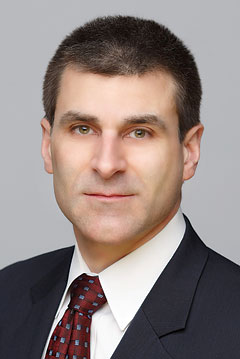
 Hedging His Bets
Hedging His Bets
Alumnus Jeff Greco maximizes his math degrees
by Amy Pavlak Laird
Jeff Greco (S’93) dreads being asked that run-of-the-mill dinner party question: What do you do for a living? For Greco, it’s not a straightforward answer. He’s worked at banks, hedge funds, a university, brokerage firms and even ran his own business. Now he works at a top actuarial consulting firm. But he’s not an actuary. And although his day-to-day duties involve quantitative analysis of market volatility for the life insurance and retirement savings industries, he’s not just a typical “quant.” When he started his first job in the finance industry, Greco didn’t know what a bond was, or an option, or even what interest rates were.
“I didn’t just not know it well,” Greco said, “I didn’t know it period.” But he learned on the job and on his own time—from books, articles, first-hand experience and others in the field.
Now a portfolio manager with Milliman Financial Risk Management LLC, the leading provider of hedging services to the retirement savings industry, Greco attributes much of his success to his time at Carnegie Mellon.
“I have to say that, just generally, a lot of the things that worked out well for me are quite honestly due to my experience at Carnegie Mellon.”
Greco arrived at Carnegie Mellon as an engineering major, but he instantly knew that engineering wasn’t for him when he realized that he wasn’t required to take many math classes beyond the first semester. He quickly turned things around—he joined the Mellon College of Science and the Department of Mathematical Sciences.
“I ended up in the math studies program, which was a godsend,” Greco said. “I had never really experienced math in a rigorous way, and my professors—Bill Hrusa, Vic Mizel, Luc Tartar—really trained me how to think critically and rigorously. I don’t know whether my experience at Carnegie Mellon was typical or uncommon, but I can definitely say that I learned how to think.”
Greco thrived as a math major, excelling in the classroom and carrying out an undergraduate research project, which is becoming more common today but was rare at the time. Greco’s research, the basis of his master’s thesis, was on the motions of a simple class of thermoviscoelastic nonconductors.
After graduating with his bachelor’s and master’s degrees, Greco pursued a Ph.D. in applied math at the University of Chicago with the goal of entering academia to teach and conduct research. After a few years he had a change of heart and left the program.
“It just didn’t feel like I was studying the things that were derived from the physical problems in the real world that I had been interested in. I thought, ‘Well, maybe there’s a better way to do that,’ ” Greco said.
Finance turned out to be just what Greco was looking for. He took a job at Dean Witter where he got a crash course in the financial industry. He spent the mornings on the trading floor, observing and talking to traders, and the rest of the time in the research department, collaborating with the research team to analyze and model new futures products and strategies.
He left Dean Witter to accept a senior research analyst position at Nation’s Bank, which later merged with Bank of America. A few years later he became a senior quantitative strategist at Deutsche Bank.
“With each job I picked up a little bit more and a little bit more. As more of the picture filled in, I started to realize that I needed to learn very well the things that I didn’t already know in order to really be a true quant in the finance industry.”
To learn what he needed to know to take the next step in his career, Greco returned to his Carnegie Mellon roots. He picked up CMU math professor Steve Shreve’s book, Stochastic Calculus for Finance.
“His book just laid out all of these obtuse and difficult topics in finance and made them very easy to understand. After you went through his book, you’re like, ‘I get it now.’ ”
Greco followed up his textbook learning by taking a two-day risk management course that Shreve offered in New York City.
“That was the missing piece. It got me on track for the rest of my career.”
At Milliman, Greco works primarily with life insurers and fund managers, developing and improving risk-management techniques that help retirement investors and insurers mitigate market risk. While he carries out the research and quantitative analysis that’s needed to run and maintain existing funds and evaluate their performance, a large part of his analysis involves building models that produce a near-term forecast of market volatility. Such models are the core component of the whole risk management process.
Although he didn’t enter academia as he had once planned, Greco found himself back at the University of Chicago in 2002 as an invited lecturer for their financial mathematics master’s degree program. He continues to teach the Fixed Income Derivatives course there as an adjunct professor.
So maybe there’s no easy answer to the dreaded dinner party question. But it’s clear that CMU—and MCS—are key characters in the story that follows.